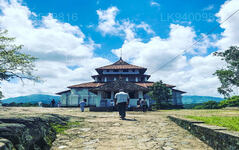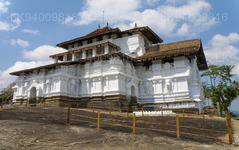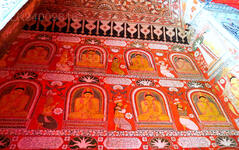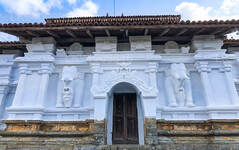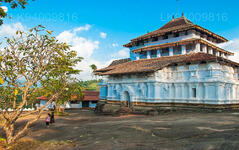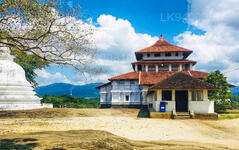
Kandy, pittoresca città dello Sri Lanka centrale, è rinomata per il suo ricco patrimonio culturale, i vivaci festival e la bellezza paesaggistica. Immersa tra lussureggianti colline, ospita il Tempio della Reliquia del Dente di Buddha, patrimonio mondiale dell'UNESCO, e offre un'affascinante combinazione di storia e splendore naturale.
Kandy, pittoresca città dello Sri Lanka centrale, è rinomata per il suo ricco patrimonio culturale, i vivaci festival e la bellezza paesaggistica. Immersa tra lussureggianti colline, ospita il Tempio della Reliquia del Dente di Buddha, patrimonio mondiale dell'UNESCO, e offre un'affascinante combinazione di storia e splendore naturale.
Lankathilaka Viharaya
Lankathilaka Viharaya in Sri Lanka: The Great Temple of the Kings
Lankatilaka is Buddhist temple of the 14th century in the Hiyarapitiya village, from the Udu Nuwara area of Kandy district in Sri Lanka. This historical temple was built by the Gampola king, King Buwanekabahu the fourth (1341 – 1351AD), in 1344 AD. Gampola was a stronghold on the banks of Mahaveli River.
Lankathilaka Viharaya in Sri Lanka: Architectural Facts
- The temple was designed by the South Indian architect Sthapati Rayar.
- According to the opinions of researchers; the temple combines the design elements of the Polonnaruwa era architecture with that of Dravidian (India) and Indo-Chinese design. At the time of construction the temple was a four storied edifice of eighty feet, built on uneven bedrock using a granite based foundation.
- The temple structure is such that it radiates from the centre in the four cardinal directions, like a cross. Only then ground floor and part of the first floor of the original temple can be seen today, though the temple appears to have three stories from the outside.
- The thick outer walls of the Temple have beautifully sculpted arches and various sculptures making it a unique design of the 14th century.
Lankathilaka Viharaya in Sri Lanka: Sights when entering the Temple
- There are two directions of approach to the temple. One of them has abodes for Buddhist monks at the base of the rock.
- The premises also have many sights such as the huge rice storage bins, known as ‘Atuwa’ by the locals. The stairs begin in the premises of the abodes.
- The other method of approach is from the west of the temple.
- With two ways of approach come two different flights of stairs. One is the original flight built in the 14th century, while the other is more recent; built around 1913. The stairs are cut into the living rock of Pahangalla and provide a climber with beautiful views of the surrounding countryside.
- At the top of the old flight of stairs, the premises of the temple can be entered through a primitive stone door arch, created with three long pieces of rock affixed together.
Lankathilaka Viharaya in Sri Lanka: The Temple
The temple premises have three sectors; the actual temple building, the Dagoba or stupa and finally the Bo tree.
The temple like the flights of stairs has two entrances, leading to two different and disconnected sections in the same building. The main and most important sector is the eastern section, the Buddha Image House. The other is on the west, the the Temples of the Gods.
The Buddha Image House
- The Buddha Image House which is approached from the eastern entrance, right in front of the eastern flight of stairs, and has a Moonstone adorning the ground before the entrance.
- Def. Moonstone: A semi-circular piece of stone which stands at the foot of a flight of steps in most historical Buddhist buildings.
- Two balustrades carved with the Gajasinha or elephant headed lion hybrid design flank the short flight of stairs leading to the entrance archway of the temple.
- The outer archway has a Makara Torana or dragon figure with some unique characteristics that differentiate it from the usual Makara Toranas.
- On the wide inside side walls of the archway display wonderfully preserved paintings of lions. A pair of guardian statues stands close to the wooden door, which has several panels painted with creepers and various designs.
- The inside of the Buddha Image House is an art masterpiece in its entirety with the walls and ceiling completely covered in beautiful paintings dating back to the construction of the temple.
- The pigments used are mostly red, white, yellow and black; with red being the dominant colour possibly because ochre was a pigment that could last the ravages of time.
- The paintings depict the lives of the 24 former Buddhas on the walls, while the ceiling has an abstract flower design.
- The centrepiece of the Buddha Image House is a beautiful golden toned seated Buddha statue. Above the statue is another Makara Torana with sculptures of angels watching over.
Lankathilaka Viharaya in Sri Lanka: Rock Inscriptions
There are inscriptions cut into the rock surface on the temple premises. The inscriptions are both in Sinhala and Tamil, stating that the land was gifted to the Temple by the kings and describing other facilities offered to the temple.
The Lankatilaka Temple is a beautiful cultural heritage of Sri Lanka that has to be visited on a holiday to the country. This temple along with the Embekke temple remains one of the most architecturally advanced structures of the Gampola Kingdom era.
Informazioni sul distretto di Kandy
Il distretto di Kandy si trova nella provincia centrale dello Sri Lanka. Uno dei sette siti Patrimonio dell'Umanità dello Sri Lanka, Kandy un tempo era la dimora dei re di Kandy nel XVI secolo e una fonte di tutta la musica, l'arte, l'artigianato e la cultura del paese. A circa 129 km da Colombo, Kandy è incastonata in un terreno collinare e tutti gli occhi sono attratti dal centro della città, dove il lago di Kandy costituisce un elemento affascinante. Kandy conserva un grande significato religioso per lo Sri Lanka, perché è in questa affascinante città che si trova il Dalada Maligawa o "Tempio del Dente", all'interno del quale giace ben custodita la sacra reliquia del dente del Signore Buddha. Il Giardino Botanico Reale di Peradeniya si trova a circa 5 km a ovest del centro città a Peradeniya ed è visitato da 1,2 milioni di persone all'anno. È il più grande giardino botanico dell'isola. L'Udawatta Kele (Foresta di Udawatta) è un santuario protetto situato nel cuore della città, appena a nord del Tempio del Dente. Kandy è una città a maggioranza singalese; vi sono comunità consistenti appartenenti ad altri gruppi etnici, come Mori e Tamil. Kandy è seconda solo a Colombo, il centro dell'economia dello Sri Lanka. Molte importanti cooperative hanno grandi filiali a Kandy e molte industrie, tra cui tessile, arredamento, informatica e gioielleria, si trovano qui. Molti centri di ricerca agricola si trovano in città. È una fonte di tutta la musica, l'arte, l'artigianato e la cultura del paese. A circa 129 km da Colombo, Kandy è immersa in un terreno collinare e tutti gli occhi sono attratti dal centro della città, dove il Lago di Kandy costituisce un elemento incantevole. Kandy conserva un grande significato religioso per lo Sri Lanka, perché è in questa affascinante città che si trova il Dalada Maligawa o Tempio del Dente, all'interno del quale è ben custodita la sacra reliquia del dente del Signore Buddha.
Informazioni sulla provincia centrale
La Provincia Centrale dello Sri Lanka è costituita principalmente da un territorio montuoso. La provincia ha una superficie di 5.674 km² e una popolazione di 2.421.148 abitanti. Alcune delle città principali includono Kandy, Gampola (24.730), Nuwara Eliya e Bandarawela. La popolazione è un mix di cingalesi, tamil e mori. Sia la capitale collinare Kandy che la città di Nuwara Eliya si trovano nella Provincia Centrale, così come Sri Pada. La provincia produce gran parte del famoso tè di Ceylon, piantato dagli inglesi negli anni '60 dell'Ottocento dopo che una devastante malattia distrusse tutte le piantagioni di caffè della provincia. La Provincia Centrale attrae molti turisti, con città collinari come Kandy, Gampola, Hatton e Nuwara Eliya. Il Tempio del Dente o Dalada Maligawa è il principale luogo sacro della provincia di Central. Il clima è fresco e molte zone intorno ai 1500 metri hanno spesso notti fredde. I pendii occidentali sono molto umidi, con precipitazioni che in alcuni punti raggiungono quasi i 7000 mm all'anno. I pendii orientali appartengono alla zona medio-secca, in quanto ricevono pioggia solo dal monsone di nord-est. Le temperature variano dai 24 °C di Kandy ai soli 16 °C di Nuwara Eliya, che si trova a 1.889 m sul livello del mare. Le montagne più alte dello Sri Lanka si trovano nella Provincia Centrale. Il territorio è prevalentemente montuoso, con profonde valli che lo attraversano. Le due principali regioni montuose sono il massiccio centrale e la catena delle Knuckles, a est di Kandy.

